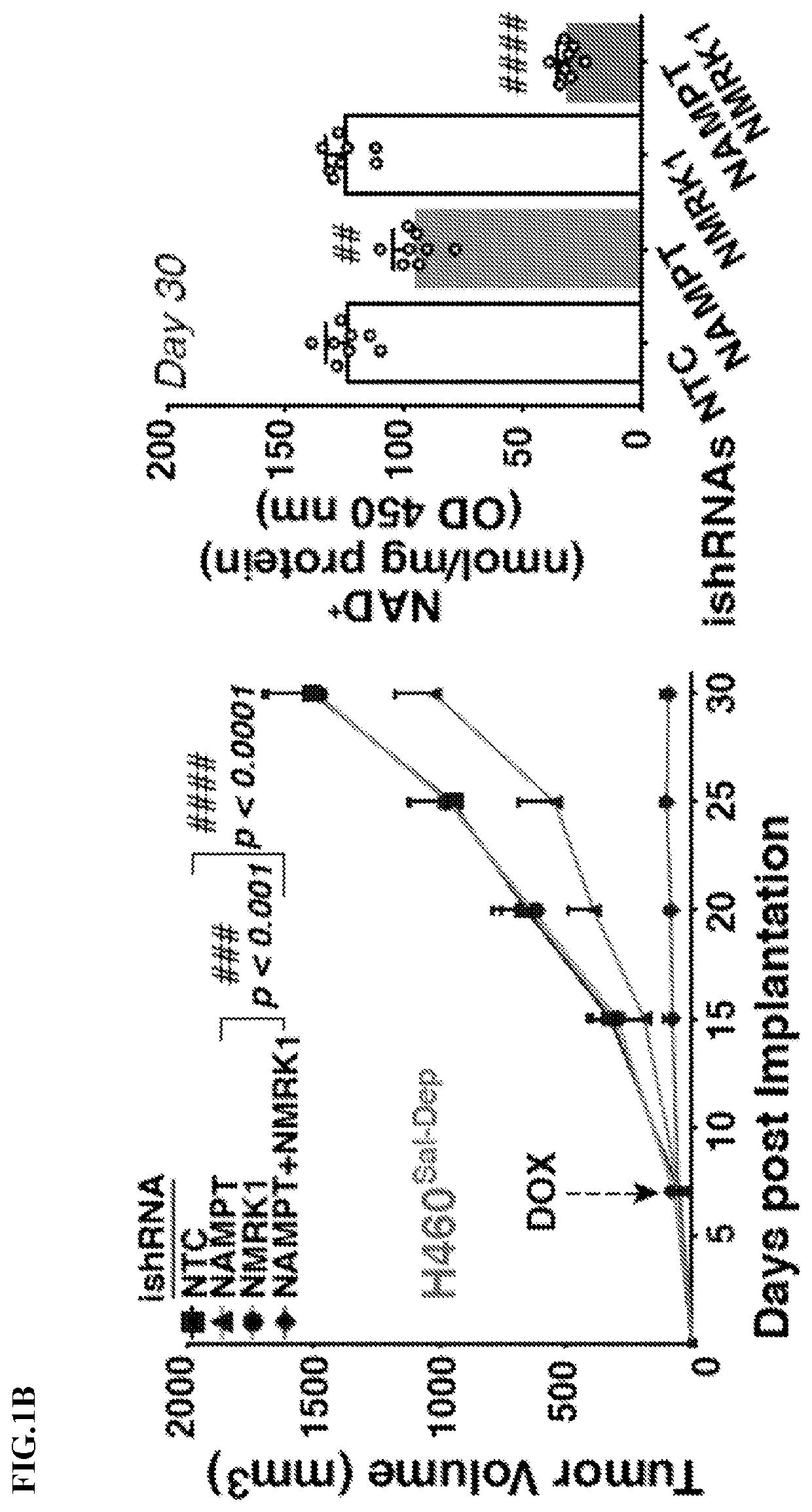Targeting nad biosynthesis in the treatment of cancer
- Summary
- Abstract
- Description
- Claims
- Application Information
AI Technical Summary
Benefits of technology
Problems solved by technology
Method used
Image
Examples
example 1
neage Dependent, PH-Pathway Addition in Cancer is Driven by Gene Amplification
[0121]The experiments herein show that tissue context was the major determinant of dependence on the nicotinamide adenine dinucleotide (NAD) metabolic pathway in cancer. By analyzing more than 7,000 tumors and 2,600 matched normal samples of 19 tissue types, coupled with mathematical modeling and extensive in vitro and in vivo analyses, a simple and actionable set of ‘rules’ was identified. Data showed that if the rate-limiting enzyme of de novo NAD synthesis, NAPRT, is highly expressed in a normal tissue type, cancers that arise from that tissue will have a high frequency of NAPRT gene amplification and be completely and irreversibly dependent on NAPRT enzyme for survival. By contrast, tumors that arise from normal tissues that do not express NAPRT gene highly are entirely dependent on the NAD salvage pathway for survival. A previously unknown enhancer that underlies this dependence was identified by expe...
example 2
n of NAD Pathways
[0145]To determine whether biosynthetic NAD dependencies in cancer are pharmacologically actionable, experiments were conducted with a substrate competitive inhibitor of bacterial NADSYN1 (See for example Ref. 19), N-(3,4-dichlorophenyl)-4-{[(4-nitrophenyl)carbamoyl]amino}benzenesulfonamide, hereafter referred to as NADSYN1i. While there appears to be no available crystal structures for the human NADSYN1 enzyme, there are several high-resolution structures available for various bacterial species, such as Bacillus subtilis (Protein Data Bank (PDB) accession 1EE1) (See for example Ref 20). Sequence alignments between the human and B. subtilis NADSYN1 show limited conservation (23%), but a remarkably high degree of sequence conservation in the binding sites for nicotinic acid adenine dinucleotide (NAAD) and ATP, as depicted in (FIG. 1C) (and see for example Ref 21). NADSYN1i has been suggested to bind competitively to the NAAD-binding site of B. subtilis (see for examp...
example 3
and Methods
[0153]The NCI-60 cell-line panel (gift from A. Shiau, obtained from NCI) was grown in RPMI-1640 with 10% fetal bovine serum (FBS) under standard culture conditions. LNCaP, PC9, CAPAN1, U-87, HEK293, IMR90, HeLa, RPE-1, and MCF10A cells used in this study were obtained from ATCC and grown according to ATCC recommendations. Normal human astrocytes were obtained from Lonza and cultured according to Lonza-specific recommendations. GBM39 and GBM6 patient-derived neurosphere lines were cultured in NeuroCult medium supplemented with epidermal growth factor, fibroblast growth factor, and heparin. KYSE510, KYSE140, and BHY cells were obtained from Leibniz-Institut DSMZ-Deutsche Sammlung von Mikroorganismen und Zellkulturen GmbH, Germany, and OE21 cells were obtained from Sigma and maintained in RPMI-1640 with 10% FBS under standard culture conditions. Cell lines obtained from NCI, ATCC, DSMZ, and Sigma were not authenticated. All cell lines were tested f...
PUM
| Property | Measurement | Unit |
|---|---|---|
| Threshold limit | aaaaa | aaaaa |
Abstract
Description
Claims
Application Information
 Login to View More
Login to View More - R&D
- Intellectual Property
- Life Sciences
- Materials
- Tech Scout
- Unparalleled Data Quality
- Higher Quality Content
- 60% Fewer Hallucinations
Browse by: Latest US Patents, China's latest patents, Technical Efficacy Thesaurus, Application Domain, Technology Topic, Popular Technical Reports.
© 2025 PatSnap. All rights reserved.Legal|Privacy policy|Modern Slavery Act Transparency Statement|Sitemap|About US| Contact US: help@patsnap.com



